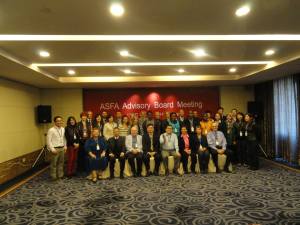Regarding the ASFA Board Meeting (13-17 Oct., 2014, Beijing) and IAMSLIC
I do not have to explain about the Aquatic Sciences and Fisheries Abstracts Data Base because I think we all know it is the main Information System specialized in marine and aquatic sciences grey literature. The 43rd Annual Meeting of the ASFA Advisory Board was hosted by the National Marine Data and Information Service (NMDIS) in Beijing from 13 to 17 October, and it was attended by 31 participants, representing 28 ASFA Partners and 3 observers. Ian Pettman (FBA) chaired the Meeting, the main rapporteur was Helen Wibley (FAO ASFA Secretariat). For your information, I am the Argentine Focal Point Coordinator of the Latin American ASFA Partners.
We have an IAMSLIC-ASFA Memorandum of Understanding (MOU), and during every Board Meeting since Richard Pepe was at the Secretariat, ASFA has always promoted very enthusiastically the IAMSLIC Z39.50/Union List and the Aquatic Commons Repository and will continue providing 37 IAMSLIC memberships that are currently funded by ASFA.
During the Fourth Day of the Meeting, several presentations were made, 2 of which I would like to mention here: 1) ‘IAMSLIC ILL tutorial for Z39.50/Union List’ (http://www.iamslic.org/wp-content/uploads/2010/07/ResourceSharing2014.pptx) presented by Mr Daryl Superio (SEAFDEC/AQD – ASFA Collaborating Centre), who is now Chair of our Resource Sharing Committee; and 2) ‘Recording data sets in ASFA: where, how and when?’ (http://vimeo.com/109003977) presented by Ms Tasmin Vicary (Freshwater Biological Association (FBA), UK ASFA Collaborating Centre) – hopefully soon to become an IAMSLIC member….
Several ASFA Trust Fund Project Proposals were approved during the Meeting, some of which involved deposition of grey literature material in Aquatic Commons. In particular, the Ugandan Trust Fund Proposal ‘Digitization of Ugandan fisheries, aquaculture and water environmental information, 1950-1990’ presented by Alice Endra (NaFiRRI), comprises 800 records to be prepared and uploaded into AC. In addition, another project proposal put forward by University of the Philippines Visayas (UPV) is pending, but it aims to scan some of the grey literature collections on fisheries, aquaculture and ocean sciences, available in the UPV/CFOS Library, that have been damaged by insects, to preserve the material by creation of digital imaging and deposition in AC.
The ASFA Board is investigating implications to the ASFA database of expanding the scope of ASFA to cover groundwater (including climate change water/sewage treatment, public water supply and water as a resource industry and agriculture).
A small group of Afriamslic members attended the Meeting and I met with them to talk about various issues. Those present were: Alice Endra – National Fisheries Resources Research Institute (NaFIRRI), Uganda; Arame G. Ndiaye Keita – Direction des Pêches Maritimes, Dakar, Senegal; Ana Maria Alfredo – Instituto Nacional de Hidrografia e Navegação (INAHINA), Maputo, Mozambique; Saida Messaoudi – Institut National des Sciences et Technologies de la Mer (INSTM), Salammbô, Tunisia;  James Macharia – Kenya Marine and Fisheries Research Institute (KMFRI), Mombasa, Kenya; and myself. Soon a short report prepared by Arame Keita, the Regional Coordinator, will be available.
The next ASFA Board Meeting will be hosted by the Northwest Atlantic Fisheries Organization (NAFO) at Dalhousie University, Halifax, NS, Canada, October 2015.
Guillermina Cosulich, Oct. 29th





